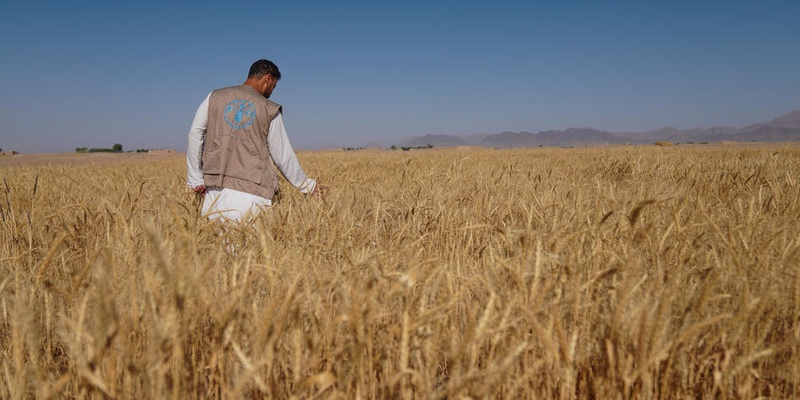Cómo impacta el cambio climático en la salud de las plantas: por qué es importante para el enfoque Una sola salud
Posted on Mar, 22 Jul 2025, 13:56

© FAO / Hashim Azizi.
En todo el mundo, el cambio climático está alterando el delicado equilibrio que mantiene sanas a las plantas, y todo lo que ellas sustentan. Con el aumento de las temperaturas, lluvias cada vez más impredecibles y fenómenos meteorológicos extremos más frecuentes, plagas y enfermedades vegetales se están propagando de maneras sin precedentes. Las consecuencias van más allá de los cultivos: en un mundo donde la salud humana, animal, vegetal y ambiental están profundamente conectadas, proteger la salud de las plantas nunca ha sido tan crucial.
La revisión científica sobre el impacto del cambio climático en plagas de las plantas, elaborada por la Organización de las Naciones Unidas para la Alimentación y la Agricultura (FAO) con la Convención Internacional de Protección Fitosanitaria (CIPF), resalta cómo el cambio climático genera nuevos riesgos para la salud vegetal, riesgos que, a su vez, afectan la seguridad alimentaria, los medios de vida, la biodiversidad y la estabilidad de los ecosistemas.
Nuevas oportunidades para plagas, enfermedades y toxinas
A medida que el clima cambia, también lo hacen las amenazas para las plantas. Temperaturas más cálidas e inviernos más benignos favorecen la supervivencia y dispersión de plagas y enfermedades hacia zonas previamente demasiado frías. La tuta absoluta (gusano cogollero del maíz), originaria de América, ha llegado a África, Asia y partes de Oceanía, destruyendo cosechas de maíz fundamentales para personas y animales. Mientras tanto, en el sur de Europa, Xylella fastidiosa ataca olivos, almendros y viñedos, impulsada por inviernos más cálidos y ecosistemas alterados.
El aumento de la temperatura, los cambios en la humedad y los ciclos de sequía e inundación afectan los cultivos y crean condiciones ideales para el desarrollo de hongos que pueden contaminar los alimentos. Algunos de estos hongos producen micotoxinas: potentes toxinas invisibles que resisten la cocción y el procesamiento.
Estos no son riesgos lejanos. Los cambios climáticos ya están influyendo en el comportamiento, la severidad y la dispersión de plagas y patógenos vegetales, y estos efectos se están acelerando.

©FAO/Fanjan Combrink.
Riesgos impulsados por el clima afectan a Una sola salud
Cuando la salud vegetal se deteriora, los efectos se propagan a la red de la vida y alcanzan la salud humana y animal. Las plantas brindan servicios esenciales del ecosistema: estabilizan el suelo, filtran el agua, almacenan carbono, regulan el clima local y sostienen la vida silvestre. Pero cuando plagas y enfermedades vegetales, incluidas especies invasoras, debilitan la salud de las plantas, estos servicios empiezan a desmoronarse.
La pérdida de salud vegetal impacta directamente a los animales. Plantas invasoras como Parthenium hysterophorus y Prosopis juliflora compiten con la vegetación nativa, reduciendo la calidad y cantidad del forraje para el ganado. Las plagas de langostas, impulsadas por condiciones climáticas favorables, pueden dejar los paisajes completamente destruidos, dejando a los pastores sin zonas de pastoreo. Y cuando los animales consumen piensos contaminados con aflatoxinas u otras micotoxinas, se comprometen su crecimiento, fertilidad e inmunidad.
Para las personas, el deterioro de la salud vegetal puede traducirse en menos disponibilidad de alimentos y mayor inseguridad alimentaria. Al igual que en animales, incrementa la exposición a sustancias nocivas presentes en cultivos básicos contaminados como el maíz, los cacahuetes y el sorgo, que pueden causar graves problemas de salud. Además, los ecosistemas degradados con pobre cobertura vegetal dejan a las comunidades menos preparadas para enfrentar eventos climáticos extremos como inundaciones, sequías y olas de calor.
El cambio climático acelera el deterioro de la salud vegetal, y esto desmantela los servicios ecosistémicos que sostienen la salud humana, animal y ambiental.
Alerta temprana y normativas internacionales son clave*
En un clima cambiante, proteger la salud de las plantas implica actuar antes y con inteligencia. Fortalecer los sistemas de alerta temprana y monitoreo de plagas ayuda a detectar amenazas emergentes antes de que se conviertan en crisis. Sistemas como el Servicio de información sobre la langosta del desierto de la FAO demuestran cómo una vigilancia oportuna puede evitar que los brotes se conviertan en crisis.
Las normas internacionales son igualmente esenciales. Las Normas Internacionales para Medidas Fitosanitarias (NIMF), desarrolladas bajo la CIPF, ayudan a los países a prevenir la propagación de plagas y enfermedades vegetales mediante el comercio global. Paralelamente, las normas del Codex Alimentarius protegen la seguridad alimentaria al establecer niveles máximos para contaminantes como las micotoxinas para reducir los riesgos a la salud humana y animal. Juntos, estos marcos ofrecen la base científica para la acción.
A medida que el cambio climático redefine los riesgos, la alerta temprana, la acción anticipada y normas internacionales robustas son vitales para proteger las plantas, y todo lo que ellas sustentan.
MÁS INFORMACIÓN
- Revisión científica sobre el impacto del cambio climático en las plagas de las plantas
- El trabajo de la FAO sobre plagas y enfermedades transfronterizas de las plantas
- Convención Internacional de Protección Fitosanitaria (CIPF)
- Cinco formas en las que el cambio climático intensifica las amenazas para la salud de las plantas
Publicado originalmente en el sitio web de la División de Producción y Sanidad Animal de la FAO: How climate change impacts plant health - and why it matters for One Health

